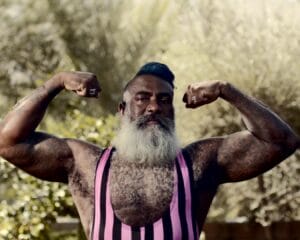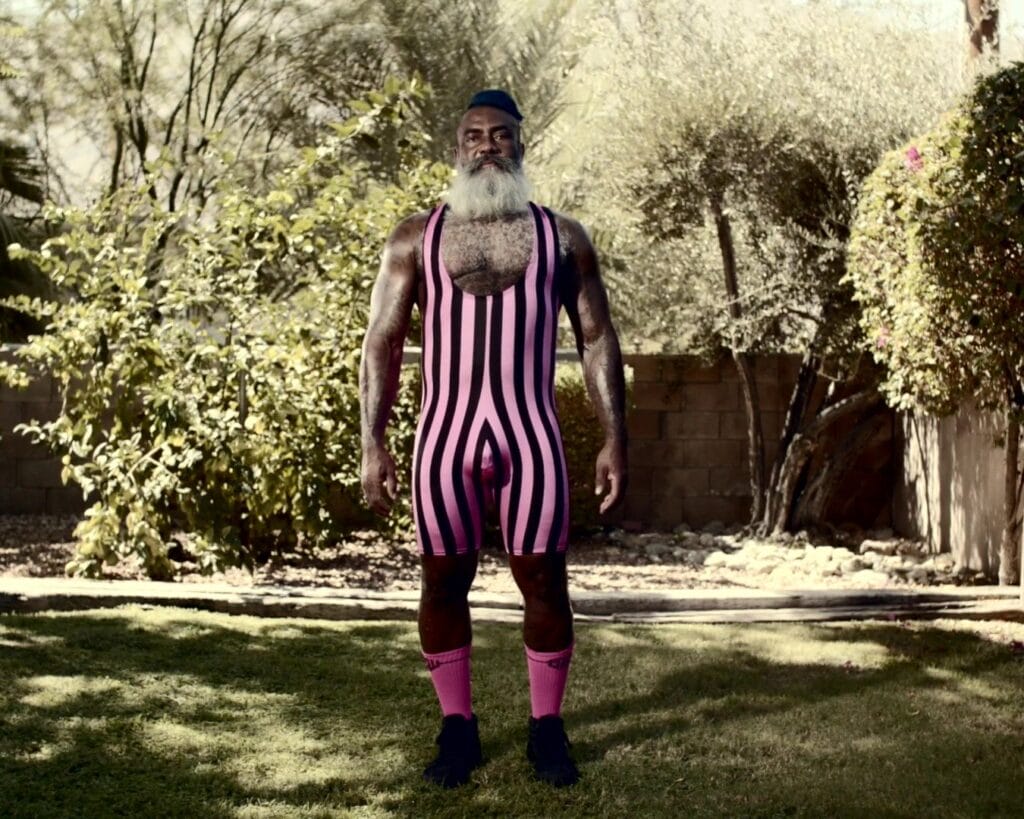Merman delves into the extraordinary life of André Chambers, a 58-year-old queer emergency nurse, leather enthusiast, husband, and civil rights activist. Directed by Sterling Hampton IV, this short documentary has received widespread acclaim since its premiere at the Tribeca Film Festival last year. Known for its innovative storytelling and captivating visuals, the film employs a rich mix of digital film, 2D animation, 3D animation, and Artificially-Generated animation to portray André’s multifaceted life.
The documentary begins with a striking auditory and visual introduction. A faint rippling water sound effect merges with a punk electric vibration, creating an evocative tone. The camera captures André in a medium shot, his serious expression setting a contemplative mood before transitioning to a warm, inviting smile. This opening scene not only introduces André but also establishes the film’s exploration of identity and self-acceptance.
As the narrative unfolds, Merman transitions seamlessly between live action and animation. A particularly imaginative animation sequence portrays André as a child as he daydreams about adorning the iconic bright green tights and orange fitted top- with a gold trident in one hand, of course, to complete the transformation. In this fantasy, he allows himself the ability to be strong and capable and heroic. André reflects on this visual representation, saying, “As a kid, I saw Aquaman as my escape—a way to imagine myself in a world where I was more than what my reality offered.”

The film’s structure alternates between intense, fast-paced moments and serene reflections. One poignant scene features André recounting his experiences with racial discrimination growing up while trying to fit into a predominantly white neighborhood. André’s narration poignantly captures this struggle: “There were times when I felt invisible, like my skin was a barrier to acceptance. It was hard trying to belong when the world seemed to push me away.” The animation here is bright and vibrant, mirroring the emotional weight of these formative experiences and emphasizing André’s feelings of isolation.
André’s reflections provide an honest and raw account of his experiences growing up as a Black queer individual. The film delves into his battles with identity and acceptance, including his encounters with racism and his journey to find a sense of belonging within the leather community. “Finding my place in the leather community wasn’t easy,” André narrates. “There were moments of rejection and misunderstanding, but each challenge shaped me into who I am today.” These reflections are interwoven with visual elements that enhance the emotional depth of his story, creating a powerful and immersive experience for viewers.
A significant portion of Merman focuses on André’s professional life as an emergency nurse. Through a blend of live action and animation, the film captures the profound impact of his work. One touching sequence features a patient he cared for during a tumultuous time returning to express his gratitude: “This job is more than just a profession; it’s a calling,” André explains. “When a patient comes back to thank me, it’s a reminder that my work makes a difference.” This sequence underscores the importance of André’s role in the community, highlighting his compassion and dedication.
View this post on Instagram
The film also explores André’s involvement in the leather community, culminating in his participation in a leather bar competition. Animated sequences and personal narration vividly portray this experience, including a racially charged comment from a fellow competitor. “You did a great job out there.” Andre repeats the harrowing words he was told. “It’s a pity you can’t win because you’re Black. André reflects on this moment, saying, “Competing was a test of my resilience. Winning was a victory not just for me, but for everyone who has faced prejudice and overcome it.” The film captures André’s triumph and the validation he felt, celebrating his achievements and resilience backed by a musical score that delivers the same feelings of inspiration and a motivated sense to the best version of yourself.
In its concluding moments, Merman reflects on André’s journey of self-acceptance and personal growth. The film uses animation to symbolically represent the reconciliation of André’s past and present selves. “Looking back, I see how far I’ve come,” André narrates. “Embracing who I am has been a journey, but it’s one that has led to a deeper understanding and acceptance of myself.”
View this post on Instagram
Sterling Hampton IV, the visionary behind Merman, is a director, producer, and composer who founded his production company COTAM (Clash of The Artistic Minds) in 2022. Hampton’s dedication to creating a multi-dimensional viewing experience is evident in Merman, where his expertise in directing, producing, editing, coloring, and composing shines through. The film’s innovative approach to storytelling and its exploration of identity, resilience, and community make it a standout piece in contemporary cinema.
Merman will be showcased at the Hammer Museum on Thursday, August 22nd at 7:30 p.m. as part of True (Short) Stories, an event highlighting recent documentary shorts from around the globe. This screening offers audiences a chance to experience the film’s unique blend of live action and animation and engage with the themes of identity and community that Merman so powerfully addresses.
View this post on Instagram
We had the opportunity to sit down with Sterling Hampton IV to discuss his creative process and the inspirations behind Merman. Here’s what he had to say:
GLAAD: What initially drew you to André Chambers’ story? Can you share the moment or experience that made you feel compelled to bring his journey to the screen?
Sterling Hampton IV: I was surfing the Instagram explore section looking for new documentary subjects after having success with my previous short documentary, Kylie. I stumbled upon a photographer’s post documenting a leather enthusiast event he had attended. In maybe the 3rd slide, I saw this awesome black and white photograph of André. He looked like a superhero. My curiosity was in learning about what makes a person into this image I had seen.
GLAAD: Can you describe your creative process in making Merman? How did you decide on the blend of live action and animation to tell André’s story, and what challenges did you encounter in this approach?
Sterling Hampton IV: Filming Merman was incredibly DIY and guerrilla style filmmaking. I went out to Palm Springs where André lives with two of my friends and filmed André’s interview and B-roll for about 7 hours. The film is comprised of that one day of filming. The decision to put animation into the film was made during post-production when I felt the film needed another interesting medium to support the story. This ended up becoming a great strength in the project due to the vibrant color and light-heartedness of the visual marrying the seriousness of the subject matter.
GLAAD: Throughout the filmmaking process, did you encounter any moments or experiences that left a significant impact on you personally? How did these moments shape your understanding of the subject matter or affect your creative vision?
Sterling Hampton IV: I realized while making the film that people experience bigotry in layers. You can be discriminated against for being a Black person, but you can also be discriminated against for being queer or a particular sex or religious affiliation. In other words, bigotry can be compounded and thus, life can be dramatically more challenging for certain people. So in essence, I believe I began to see even more need for empathy in society and I saw even more reason to continue making an effort in trying to see the world through other people’s experiences.
GLAAD: Was there a specific moment in the film’s production where you felt that the project truly came together? Can you describe that moment and its significance for you as a filmmaker?
Sterling Hampton IV: In post-production, once I felt the energy from the initial introduction sequence, I knew it would deliver a visceral reaction that was not only visually stimulating but also useful for challenging perception.
GLAAD: What do you hope audiences take away from Merman? Are there any particular messages or themes you intended to highlight through André’s story?
Sterling Hampton IV: I hope that people realize that people face bigotry in layers and that it’s important to challenge your perception of others. Really, this just means being a critical thinker, which is especially important in this day and age because we are constantly bombarded with others’ ideals and agendas. In reality, everybody wants the same thing: financial security, health, and love. When you start with that as the foundation, we should really find indifference to things like skin color, religion, sexual orientation, or gender. Our minds should be interested in hearts and knowledge.
GLAAD: Looking back on the entire process of creating Merman, what are your reflections on the role of storytelling in amplifying diverse voices and experiences? How has this project influenced your perspective on filmmaking?
Sterling Hampton IV: When you can tell a story about a person from a particular community of people, it’s important to do so with respect, empathy, and detail-orientedness. I think it’s important for stories like this to be told because they serve as a mirror on ourselves. We can learn about ourselves through others and about others via ourselves. Art should always act as a catalyst for conversation. Through that conversation comes consideration. From that consideration, hopefully, comes change. When we change, we evolve and grow. When we grow, there is more light.
GLAAD: Do you have any future projects or stories that you’re excited about exploring? How do you see your experience with Merman influencing your work moving forward?
Sterling Hampton IV: I have several projects in short form and long form that I’m looking forward to sharing soon. These projects range dramatically in their subject matter but all feel a part of my creative mission: that is to inspire, challenge, and enlighten.
_____________________________________________________________________________
For more information about the screenings, visit True (Short) Stories website.
To keep up with Sterling Hampton IV’s work and stay updated on his latest projects, follow him on Instagram at @mastersterling and on Twitter at @mastersterlings.













